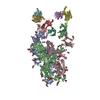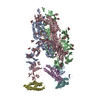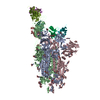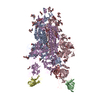[English] 日本語
 Yorodumi
Yorodumi- PDB-7tat: SARS-CoV-2 spike in complex with the S2K146 neutralizing antibody... -
+ Open data
Open data
- Basic information
Basic information
| Entry | Database: PDB / ID: 7tat | ||||||
|---|---|---|---|---|---|---|---|
| Title | SARS-CoV-2 spike in complex with the S2K146 neutralizing antibody Fab fragment (two receptor-binding domains open) | ||||||
 Components Components |
| ||||||
 Keywords Keywords | VIRAL PROTEIN/IMMUNE SYSTEM / SARS-CoV-2 / COVID-19 / spike glycoprotein / fusion protein / neutralizing antibodies / Structural Genomics / Seattle Structural Genomics Center for Infectious Disease / SSGCID / inhibitor / VIRAL PROTEIN-IMMUNE SYSTEM complex | ||||||
| Function / homology |  Function and homology information Function and homology informationMaturation of spike protein / viral translation / Translation of Structural Proteins / Virion Assembly and Release / host cell surface / host extracellular space / suppression by virus of host tetherin activity / Induction of Cell-Cell Fusion / structural constituent of virion / entry receptor-mediated virion attachment to host cell ...Maturation of spike protein / viral translation / Translation of Structural Proteins / Virion Assembly and Release / host cell surface / host extracellular space / suppression by virus of host tetherin activity / Induction of Cell-Cell Fusion / structural constituent of virion / entry receptor-mediated virion attachment to host cell / host cell endoplasmic reticulum-Golgi intermediate compartment membrane / receptor-mediated endocytosis of virus by host cell / Attachment and Entry / membrane fusion / positive regulation of viral entry into host cell / receptor-mediated virion attachment to host cell / receptor ligand activity / symbiont-mediated suppression of host innate immune response / host cell surface receptor binding / fusion of virus membrane with host plasma membrane / fusion of virus membrane with host endosome membrane / viral envelope / virion attachment to host cell / SARS-CoV-2 activates/modulates innate and adaptive immune responses / host cell plasma membrane / virion membrane / identical protein binding / membrane / plasma membrane Similarity search - Function | ||||||
| Biological species |   Homo sapiens (human) Homo sapiens (human) | ||||||
| Method | ELECTRON MICROSCOPY / single particle reconstruction / cryo EM / Resolution: 3.2 Å | ||||||
 Authors Authors | Park, Y.J. / Seattle Structural Genomics Center for Infectious Disease (SSGCID) / Veesler, D. | ||||||
| Funding support |  United States, 1items United States, 1items
| ||||||
 Citation Citation |  Journal: Science / Year: 2022 Journal: Science / Year: 2022Title: Antibody-mediated broad sarbecovirus neutralization through ACE2 molecular mimicry. Authors: Young-Jun Park / Anna De Marco / Tyler N Starr / Zhuoming Liu / Dora Pinto / Alexandra C Walls / Fabrizia Zatta / Samantha K Zepeda / John E Bowen / Kaitlin R Sprouse / Anshu Joshi / Martina ...Authors: Young-Jun Park / Anna De Marco / Tyler N Starr / Zhuoming Liu / Dora Pinto / Alexandra C Walls / Fabrizia Zatta / Samantha K Zepeda / John E Bowen / Kaitlin R Sprouse / Anshu Joshi / Martina Giurdanella / Barbara Guarino / Julia Noack / Rana Abdelnabi / Shi-Yan Caroline Foo / Laura E Rosen / Florian A Lempp / Fabio Benigni / Gyorgy Snell / Johan Neyts / Sean P J Whelan / Herbert W Virgin / Jesse D Bloom / Davide Corti / Matteo Samuele Pizzuto / David Veesler /    Abstract: Understanding broadly neutralizing sarbecovirus antibody responses is key to developing countermeasures against SARS-CoV-2 variants and future zoonotic sarbecoviruses. We describe the isolation and ...Understanding broadly neutralizing sarbecovirus antibody responses is key to developing countermeasures against SARS-CoV-2 variants and future zoonotic sarbecoviruses. We describe the isolation and characterization of a human monoclonal antibody, designated S2K146, that broadly neutralizes viruses belonging to SARS-CoV- and SARS-CoV-2-related sarbecovirus clades which use ACE2 as an entry receptor. Structural and functional studies show that most of the virus residues that directly bind S2K146 are also involved in binding to ACE2. This allows the antibody to potently inhibit receptor attachment. S2K146 protects against SARS-CoV-2 Beta challenge in hamsters and viral passaging experiments reveal a high barrier for emergence of escape mutants, making it a good candidate for clinical development. The conserved ACE2-binding residues present a site of vulnerability that might be leveraged for developing vaccines eliciting broad sarbecovirus immunity. | ||||||
| History |
|
- Structure visualization
Structure visualization
| Movie |
 Movie viewer Movie viewer |
|---|---|
| Structure viewer | Molecule:  Molmil Molmil Jmol/JSmol Jmol/JSmol |
- Downloads & links
Downloads & links
- Download
Download
| PDBx/mmCIF format |  7tat.cif.gz 7tat.cif.gz | 637.2 KB | Display |  PDBx/mmCIF format PDBx/mmCIF format |
|---|---|---|---|---|
| PDB format |  pdb7tat.ent.gz pdb7tat.ent.gz | 501.5 KB | Display |  PDB format PDB format |
| PDBx/mmJSON format |  7tat.json.gz 7tat.json.gz | Tree view |  PDBx/mmJSON format PDBx/mmJSON format | |
| Others |  Other downloads Other downloads |
-Validation report
| Summary document |  7tat_validation.pdf.gz 7tat_validation.pdf.gz | 1.7 MB | Display |  wwPDB validaton report wwPDB validaton report |
|---|---|---|---|---|
| Full document |  7tat_full_validation.pdf.gz 7tat_full_validation.pdf.gz | 1.7 MB | Display | |
| Data in XML |  7tat_validation.xml.gz 7tat_validation.xml.gz | 93.4 KB | Display | |
| Data in CIF |  7tat_validation.cif.gz 7tat_validation.cif.gz | 146.5 KB | Display | |
| Arichive directory |  https://data.pdbj.org/pub/pdb/validation_reports/ta/7tat https://data.pdbj.org/pub/pdb/validation_reports/ta/7tat ftp://data.pdbj.org/pub/pdb/validation_reports/ta/7tat ftp://data.pdbj.org/pub/pdb/validation_reports/ta/7tat | HTTPS FTP |
-Related structure data
| Related structure data |  25784MC  7tasC M: map data used to model this data C: citing same article ( |
|---|---|
| Similar structure data |
- Links
Links
- Assembly
Assembly
| Deposited unit | 
|
|---|---|
| 1 |
|
- Components
Components
| #1: Protein | Mass: 142427.438 Da / Num. of mol.: 3 Mutation: R682G,R683S,R685S,F817P,A892P,A899P,A942P,K986P,V987P Source method: isolated from a genetically manipulated source Source: (gene. exp.)  Gene: S, 2 / Production host:  Homo sapiens (human) / References: UniProt: P0DTC2 Homo sapiens (human) / References: UniProt: P0DTC2#2: Antibody | Mass: 13381.938 Da / Num. of mol.: 3 Source method: isolated from a genetically manipulated source Source: (gene. exp.)  Homo sapiens (human) / Production host: Homo sapiens (human) / Production host:  Homo sapiens (human) Homo sapiens (human)#3: Antibody | Mass: 11275.328 Da / Num. of mol.: 3 Source method: isolated from a genetically manipulated source Source: (gene. exp.)  Homo sapiens (human) / Production host: Homo sapiens (human) / Production host:  Homo sapiens (human) Homo sapiens (human)#4: Polysaccharide | 2-acetamido-2-deoxy-beta-D-glucopyranose-(1-4)-2-acetamido-2-deoxy-beta-D-glucopyranose Source method: isolated from a genetically manipulated source #5: Sugar | ChemComp-NAG / Has ligand of interest | N | |
|---|
-Experimental details
-Experiment
| Experiment | Method: ELECTRON MICROSCOPY |
|---|---|
| EM experiment | Aggregation state: PARTICLE / 3D reconstruction method: single particle reconstruction |
- Sample preparation
Sample preparation
| Component |
| ||||||||||||||||||||||||
|---|---|---|---|---|---|---|---|---|---|---|---|---|---|---|---|---|---|---|---|---|---|---|---|---|---|
| Molecular weight | Experimental value: NO | ||||||||||||||||||||||||
| Source (natural) |
| ||||||||||||||||||||||||
| Source (recombinant) |
| ||||||||||||||||||||||||
| Buffer solution | pH: 8 | ||||||||||||||||||||||||
| Specimen | Embedding applied: NO / Shadowing applied: NO / Staining applied: NO / Vitrification applied: YES | ||||||||||||||||||||||||
| Vitrification | Cryogen name: ETHANE |
- Electron microscopy imaging
Electron microscopy imaging
| Experimental equipment |  Model: Titan Krios / Image courtesy: FEI Company |
|---|---|
| Microscopy | Model: FEI TITAN KRIOS |
| Electron gun | Electron source:  FIELD EMISSION GUN / Accelerating voltage: 300 kV / Illumination mode: FLOOD BEAM FIELD EMISSION GUN / Accelerating voltage: 300 kV / Illumination mode: FLOOD BEAM |
| Electron lens | Mode: BRIGHT FIELD / Nominal defocus max: 2500 nm / Nominal defocus min: 500 nm |
| Image recording | Electron dose: 60 e/Å2 / Film or detector model: GATAN K3 (6k x 4k) |
- Processing
Processing
| EM software |
| |||||||||
|---|---|---|---|---|---|---|---|---|---|---|
| CTF correction | Type: PHASE FLIPPING AND AMPLITUDE CORRECTION | |||||||||
| 3D reconstruction | Resolution: 3.2 Å / Resolution method: FSC 0.143 CUT-OFF / Num. of particles: 348047 / Symmetry type: POINT |
 Movie
Movie Controller
Controller












 PDBj
PDBj







